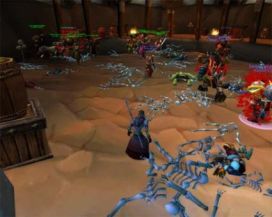I’m diseased and sniffing, but what about animals that can sniff out diseases?
We’ve all heard stories of dogs who sniff out cancer so here are 4 (and a half?) other animals which can sniff out diseases like tuberculosis.
I’m diseased and sniffing, but what about animals that can sniff out diseases?
We’ve all heard stories of dogs who sniff out cancer so here are 4 (and a half?) other animals which can sniff out diseases like tuberculosis.
Australia Skeptics Inc award the Bent Spoon Prize every year.
“The Bent Spoon is the least sought-after award in Australia”, says Richard Saunders, president of Australian Skeptics Inc. “It’s issued each year at the Skeptics annual convention to the ‘perpetrator of the most preposterous piece of paranormal or pseudo-scientific piffle’.”
The winner of the 2013 award was won jointly by the Chiropractors’ Association of Australia AND the Chiropractic Board of Australia. Surprise, surprise.
Read more here.

Remember how we used to scotchgard our shoes? It turns out that Mother Nature has yet again upped us on this frontier with not only equipping the lotus leaf with the required hydrophobic residue but also increasing it’s surface area via microscopic bumps so that water droplets run off the surface much quicker. This superhydrophobic quality could be applied in our everyday lives, making cleaning a much easier process (I hope!)
“Scotchgard it with your life!”
Read more at the Guardian.
I’ve decided that this blog was becoming a little dry so I’m going to try and engage with it a little bit more, starting with something that I used to play a lot: World of Warcraft (WoW).
 There was a very interesting paper on the potential of using WoW as an epidemiological tool after the Corrupted Blood outbreak in 20051. The authors of the paper suggest that since players invest much of their time into their alter ego, these virtual models are a truer representation of disease transmission compared with simulations based on algorithms or prediction models.
There was a very interesting paper on the potential of using WoW as an epidemiological tool after the Corrupted Blood outbreak in 20051. The authors of the paper suggest that since players invest much of their time into their alter ego, these virtual models are a truer representation of disease transmission compared with simulations based on algorithms or prediction models.
The authors also suggested that healers in the game were reminiscent of first responders (e.g. doctors) and the similarities in behaviour provide insight for disease transmission with health-care workers. The authors did acknowledge that the reproductive rate of the disease was staggeringly high, and put it down to very large town centres with extremely high population density. Furthermore, they identified Non-Player Characters (NPCs; usually have a lot of health) as on-going reservoirs or carriers, if you will, of the particular disease.
I found the concept of using Multiplayer Online Role Play Games (MMORPG) as an epidemiological tool very interesting and almost enticing. However, there are a couple of things I would point out and pin-point for any future researchers thinking of employing such a game for epidemiological studies.
I do agree that using multiplayer games have some advantage over simulations because, as any economist will tell you, humans hardly act according to algorithms and are unpredictable. I suppose what one could do is to test an algorithm out using Mass MMORPGs and then tweak the algorithm accordingly.
One of the other advantages of WoW is that there are over a hundred servers, each runs a parallel world in real time which means that a researcher could potentially perform simultaneous scenarios for a good sample size (n) which will aid in data accuracy (1 server = 1 n even though within 1 server there are thousands of players, but the result of one event is still hypothetical and hence I think should be calculated as one result).
However, in some ways, the numbers achieved are somewhat inflated because:
1. There is no acquired immunity.
Players in this game are able to resurrect and without acquired immunity from previous infection, they will quickly contract the disease and die again. And again. And again. Basically, the Rn will always = Ro. There is also no race advantage or disadvantage towards the disease (e.g. Africans and malaria; Asians and diabetes etc).
2. Players are curious.
We want to explore this new world that we pay $15/month to play and if a historical event is occurring, we want to be in the action. Where in any normal life event people would be staying away from the epicentre of the disease, I would vouch that most players would travel to it just to check it out, I remember once they introduced zombies as part of the leadway to an expansion release and these zombies would kill you but for the first few days you couldn’t really tell how or why they did. There was no news about them and what their purpose was, so of course everybody was there conducting their “scientific experiments”; poking the zombies around and trying to figure out what was going on. As a result, of course, quite a few players died. Which leads me to my next point..
3. Players don’t feel sick
Quite often disease spread is somewhat limited by the symptoms of the disease e.g. malaise, fever etc and so you tend not to be as active as when you are healthy whereas players would just act as if they were healthy until they literally dropped dead. This is especially true for the higher level players who could last awhile before dying and I suppose the worst ones are the high level healers who could heal themselves and, in a sense, have a chronic manifestation of Corrupted Blood (or whatever other disease).
4. Players are silly.
Its a game and we want to do silly things so we might devise many a scenario which could potentially inflate the infection/death rate e.g. deliberately getting infected to see if the infection can be passed on to random things in the game, or so a healer can test out his rotations or see if he has a spell to remove the disease etc. I remember once there was a game bug where you could trigger a spontaneous death and so some players would deliberately die and resurrect to spell out words with their bones (because the bones don’t disappear straightaway).
5. 1 player = several characters
You could make 20 characters/server and play them as you pleased so even though statistics say things like, 1000 characters died in the epidemic, you might only be seeing the behaviour pattern of 50 actual players; but again, that is hard to say since not everybody has the time to play that many characters.
I suppose the factor most influencing players to not act like real world people is the fact that there are no long term consequences in the game (i.e. you never really die) and so our actions only somewhat mimic real world actions. If one were to truly perform epidemiological studies in MMORPGs, they would have to change quite a bit of the gameplay (e.g. sickness reducing some talents, not being able to resurrect etc) which would probably make the players suspicious about the whole thing and either create lots of enemies (players are pretty irate people) or, worse, conspiracy theories which kind of ruins the whole “blind study” scenario.
The other thing is I guess the game could track the IP of the players and remove all duplicate results from the same IP (although this will affect multiple players within the one household or LAN shops).
I was interested to read that “healers rushed to cities to heal other players” as this has not been my experience with the game. I suppose in the olden days players were more generous and it also depends on what server/faction you are in; but there is certainly no advantage for healers to keep healing other players unless they could remove the disease as well so I’m not sure if they are the best representations of “first responders”.
In terms of demographic representation, there might be a higher percentage of players between 12-40 year old range, but have found that the gender balance is quite equal and since there were American and Oceania servers, geographic/race distribution was also quite good.
Reference
1. Lofgren ET and Fefferman NH (2007) The untapped potential of virtual game worlds to shed light on real world epidemics. Lancet Infectious Diseases 7:625-629

I don’t actually know what that chinese word means, but I thought the blog needed more pictures :p
Yes music can be broken down into math, but for one algorithm at least, music got the upper hand by proving the 200 year old Fourier transform wrong.
Its payback for everyone picking on the biologists :p
Not my own, but that from GEN. From transplants without waiting lists to Star Trek diagnostics, it is an interesting 10 min read and worth having a look; even if you only skim through the headlines and read the stuff that really interests you.